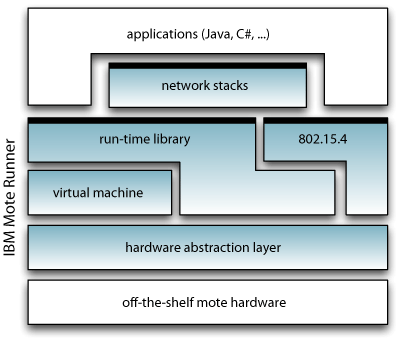by Thorsten Kramp, Michael Baentsch, Thomas Eirich, Marcus Oestreicher, Ivan Romanov
and Alexandru Caraças
Wireless sensor networks may well be the next big thing. Nevertheless, a fully business-process-integrated infrastructure for deploying large numbers of sensors and actuators requires a well-designed ecosystem. This should combine inexpensive devices with simple, bulletproof device programmability for easy integration and use by application domain specialists. The IBM Mote Runner system addresses this challenge with a high-performance, low-footprint middleware platform comprising a hardware-agnostic and language-independent virtual machine together with development and integration tooling to easily create and manage applications for open sensor and actuator networks.
One-way, dedicated data-gathering IT networks such as those underlying, for example, a delivery tracking system, have shown the commercial value of real-time control of real-world components. Building on this, more generalized applications for wireless sensor networks (WSNs) are becoming increasingly apparent and significant in size and real-world relevance. Conceptually, the broadest application categories for WSNs involve environmental information, and provide a flexible communication and intelligence-gathering infrastructure that serves, for example, next-generation business applications by allowing them to directly tap into the ever greater number of digitally-enabled sensors and actuators that provide input to and control of their operation.
To unlock this potential, however, two first-order problems must be addressed. One is cost: WSNs consist of many small computing elements that must be cost optimized. In this realm, cost takes the form of up-front investments in hardware and software plus any subsequent investments (eg for maintenance). Minimizing up-front investment requires minimum hardware cost, and this necessitates very efficient software running on the least expensive and most cost-effective off-the-shelf chips (or 'motes'). Minimizing subsequent investments translates into design requirements for minimum hardware interaction after mote deployment (eg for manual battery change or system reconfiguration).
The second problem is technological: a WSN run-time environment must not only be able to cope with the broad range of technical challenges imposed on WSNs but it must equally be accessible beyond the low-level functionality of individual WSN nodes. Here, 'accessible' refers to three things. First, it must be possible to dynamically configure and reconfigure the WSN in the field to deal with situations such as interrupted communication or WSN node failures. Second, it is necessary to secure the WSN in order that it may be considered a trusted source of information and reliable performer of actions in response. Third, the WSN must be well integrated into the larger infrastructure with which it cooperates. It must be generally programmable by domain specialists to solve domain-specific problems without deep knowledge of WSN technology and components. Only then are real-world solutions possible which link while being easy to program and deploy the physical world of sensors and actuators with business processes and applications. The result is the desired improvement in the responsiveness of transactions, enabling end-to-end process security and reducing cost by effectively using WSNs for data collection, pre-processing and autonomic feedback.

The IBM Mote Runner run-time environment for wireless sensor networks, currently under development at the IBM Zurich Research Laboratory, tackles these challenges in a holistic manner. At its core, Mote Runner provides a high-performance, resource-efficient virtual machine that is compatible with high-level languages and which shields portable applications from hardware specifics. It is designed to run on very small standard embedded controllers including low-power 8-bit processors, thereby reducing initial investment costs. Furthermore, it allows programmers to use object-oriented programming languages and development environments such as C# and Java to develop portable WSN applications that may be dynamically distributed, loaded, updated, and deleted even after the WSN hardware has been deployed, thereby reducing post-deployment and maintenance costs. All operations and communications can be cryptographically protected to establish a trusted execution environment. Figure 1 illustrates how this all fits together. Finally, Mote Runner WSN applications provide seamless integration with state-of-the-art back-end infrastructures by means of an event-driven process engine, which effectively bridges the gap to large-scale business and scientific applications without requiring deep technology skills.
Link:
http://www.zurich.ibm.com/moterunner
Please contact:
Thorsten Kramp
IBM Zürich Research Laboratory, Switzerland
E-mail: thk![]() zurich.ibm.com
zurich.ibm.com










